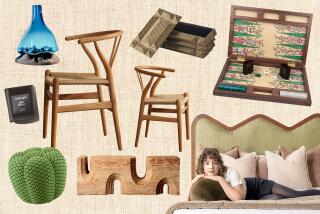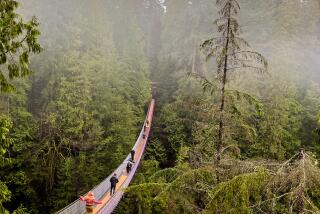Helsinki’s Modern approach
- Share via
HELSINKI, FINLAND — “I’d prefer to face indoors,” I said to my friends Christopher and Dirk, who had taken me out for dinner on my first night in Finland’s capital last October.
We were about to be seated at Lasipalatsi, the “glass palace” restaurant. Although the view through the wall of windows was compelling -- with the sharp angles of the Kiasma contemporary art museum on one end, the intricate brickwork of Stockmann Department Store on the other and trams and pedestrians coursing along the wide boulevard below -- I was drawn to the warm reds and beiges, deep-grained blond woods and clean lines of the interior.
Fall and winter, with long nights and chilly temperatures, may not seem like the best seasons to visit Helsinki, but for design fans it’s prime time. The action moves indoors to the Modernist spaces that have made this country famous -- shops, hotels, restaurants -- plus a whole design district.
This is your chance to see the home base of familiar Modern designers, such as Alvar Aalto (1898-1976), the architect and furniture designer who was one of the first to make good design affordable. You’ve seen his work even if you didn’t know it was his: three-legged birch stools with legs rounded at the top, Savoy pattern glass vases that cradle flowers in their many crannies, geometric-patterned hanging lamps in lightweight, white-painted aluminum.
This also is the home of other design icons: Eliel and Eero Saarinen (buildings and furniture), Marimekko (textiles), Iittala (tableware), Fiskars (scissors), even Nokia (phones).
DESIGN CENTRAL
A design district in the town center continues to nurture this creativity. People here speak of designers with the reverence that Angelenos reserve for film directors.
The Design Museum is like taking Finnish Design 101. Although the 19th century building is Beaux Arts in style, its permanent collection focuses on the 20th century, minimalist and functional: ceramics in eternal shapes, blown glass, silver coffee servers and a whole wall of chairs. Exhibits stop around the 1980s, but the evolution is plain to see, from frilly, ornamental forms you might imagine in the palace of Russia’s Catherine the Great through simple Midcentury forms that remain important today.
Armed with this visual vocabulary, I next visited the nearby Design Forum Finland, a foundation that brings together dozens of contemporary artists and designers in special exhibits and a shop that had me saying, “Wow!” every few feet. I was tempted by Mika Ihanus’ easy-to-hold chopsticks, whose top ends twist like trees in the wind; Tonfisk Design’s white cylindrical coffee carafes, with cork caps and shells of bent birch at the base; tiny, flat, white, square ceramic plates with rounded corners, nesting in an oblong tray; flower-shaped reflectors for you (or your dog) to wear while walking at night.
The design district is just out the door, with about 150 shops and restaurants mostly clustered in a four-by-six-block section of the Punavuori neighborhood, a few blocks west of the harbor and south of the central railway station.
I quickly found myself browsing in a shop called Secco, whose Treasures of Wasteland collection recycles old materials into new. Inner tubes become shoulder bags; computer keys become key rings, jewelry and refrigerator magnets; UNICEF bags for shipping rice are transformed into slippers; old zippers find new life as bracelets; and used LPs become bowls and letter holders.
Sprinkled among the design district’s dozens of shops selling housewares are tiny clothing boutiques, which include cutting-edge designers such as Hanna Saren and Ivana Helsinki, the first Finnish design house on the 2007 Paris Fashion Week runway, with “Fennofolk” designs that combine Scandinavian and Slavic motifs.
Then there are collectives such as HundPark, where young designers make a name for themselves with clothing and accessories, including hats, dolls and casual and club wear for men and women. My favorites -- black-and-white woolen caps knitted with an airplane pattern, and a handkerchief printed with: “Oh, I think I dropped my handkerchief.”
Marimekko mecca
If you’re after established brands for the home, head to Esplanadi, the boulevard on either side of Esplanade Park, about a 10-minute walk away. First stop has to be Artek, the company Aalto started with his wife, Aino, and other collaborators. His three-legged 60 stool has never gone out of style.
Across the street is Marimekko, whose Kaivo pattern wall hanging (which looks like three eyes stacked atop one another) was an icon in the ‘70s. This pattern remains ever popular, alongside table linens and clothes in Marimekko’s signature bright colors, spots, stripes and patterns.
Down the block is Iittala, Finland’s best-known maker of tableware. It’s the official manufacturer of the Alvar Aalto line. While there, I shadowed some Japanese tourists, who declared the triangular bowls, stacking coffee servers and penguin-shaped pitchers “oshare” (cool).
It would be easy to spend a day or two shopping; maps of Design District Helsinki are available at shops, hotels and tourist offices. Prices, even accounting for the exchange rate, are similar to what you would pay for designer and handcrafted goods stateside; Aalto’s 60 stool, for example, retails at Artek for $169, comparable with online retailers.
While exploring Helsinki, be sure to sample some of the city’s atmospheric cafes and restaurants too. Perfect for a leisurely meal or a quick warmup.
Better yet, this is the land of the sauna -- one of Finland’s great gifts to the world. Many homes and hotels here have them. I went with Christopher and Dirk to a historic gem of a sauna and pool, the municipal Yrjonkatu Swimming Hall, tucked into a corner just a quick walk from the design district.
Although there’s nothing Modernist about the building’s 1928 interior, it’s one of the city’s most memorable spaces. Encircling the pool are two stories of columns in shades of blue from sky through robin’s egg to royal, with white-curtained cabanas on the second level. Clothing is optional here -- no one I saw in the pool wore anything more than a kickboard -- and different days belong to each gender.
For this Angeleno, the sauna delivered on its promise of warmth and relaxation and turned the chill into a wintry mirage.
--
--
(BEGIN TEXT OF INFOBOX)
Planning this trip
THE BEST WAY
From LAX, connecting service (change of planes) to Helsinki is available on Air France, American, British, KLM, Lufthansa. Restricted round-trip fares begin at $630.
TELEPHONES
To call the number below from the U.S., dial 011 (the international dialing code), 358 (the country code for Finland) and the local number.
WHERE TO SHOP
Design Museum, 23 Korkeavuorenkatu; www.designmuseum.fi.
Design Forum Finland, 7 Erottajankatu; www.design forum.fi.
Secco, 33 Frederikinkatu; www.seccoshop.com.
Hanna Saren, 45 Frederikinkatu; www.hannasaren.com.
Ivana Helsinki, 15 Uudenmaankatu; www.ivanahelsinki.com.
Hundpark, 17-19 Iso Roobertinkatu; www.hundpark.net.
Artek, 18 Etelaesplanadi; www.artek.fi.
Marimekko, Kamp Galleria, 31 Pohjoisesplanadi; www.marimekko.com.
Iittala, 25 Pohjoisesplanadi; www.iittala.com.
WHERE TO EAT
Cafe Aalto, 1 Keskuskatu; 9-121-4446, www.cafeaalto.fi. The cafe is inside the Aalto-designed Academic Bookstore. Cool your jets over a lunch of salmon pie. Entrees $11 to $14.
Demo, 9-11 Uudenmaankatu; 9-2289-0840, www.restaurantdemo.fi. This Michelin-starred restaurant in the Design District serves inventive, contemporary international cuisine. Four-course dinner $79.
Lasipalatsi, 22-24 Mannerheimintie; 20-7424-290; ravintola.lasipalatsi.fi. Try the Helsinki menu (grilled elk, perch, and a pancake of Lappish cheese for dessert). Entrees $23 to $41.
TO LEARN MORE
Scandinavian Tourist Boards, (212) 885-9700, www.gofinland.org.
--
On travel.latimes.com
For more angles on Helsinki, see www.latimes.com/finland.
More to Read
The biggest entertainment stories
Get our big stories about Hollywood, film, television, music, arts, culture and more right in your inbox as soon as they publish.
You may occasionally receive promotional content from the Los Angeles Times.










